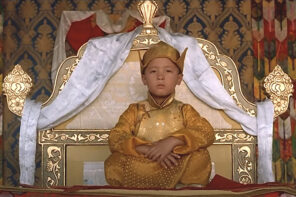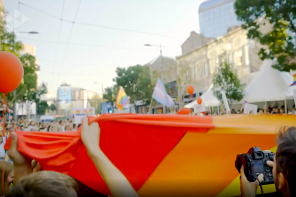Louis said to Delia, “That’s the sad thing with life”
“People always leaving just as other folks arrive.”
The angels laid her away.
—Josh Ritter, “Folk Bloodbath”
“People always leaving just as other folks arrive.” That is the line that suddenly came to mind when I learned that Father Matthew Kelty left this world peacefully at noon on Friday last. This is a great loss to those of us newly, and not-so-newly, arrived, and I wanted to try to explain why I think this is so. This remarkable monk spent fifty off-and-on years at the Abbey of Gethsemani in Kentucky, where he was the last confessor that Thomas Merton ever had; and if that wasn’t enough to warrant further discussion, he was also a gay priest who came out in one of his most eloquent essays at the ripe old age of ninety. We will not soon see the likes of such monks again.
Father Matthew’s story is not as well-known as it deserves to be, in large measure because his story was so deeply intertwined with the story of Thomas Merton (1915-1968), arguably the most famous monk that the Abbey of Gethsemani, and American Catholicism, ever produced.
Father Matthew was neither famous nor self-promoting, which is what makes the lyrical strains of the notes he did produce so very eloquent and so very worth our hearing.
Both men seem to me now the product of a different age and a different time, and more to the point, both men were the result of a different way of inhabiting time—a monastic, a poetic, and ultimately a rather silent way. Both men came of age in postwar America, and both were intimately involved in the vast cultural thought experiment we associate with the 1960s: the attempts to re-imagine race, sex, nation, and religion. We need their voices, and we need to remind ourselves of the existence of such voices against the background cultural cacophony of our own day.
Kelty via Merton
I trust that it will be in keeping with the quiet humility of Father Matthew Kelty if I use Thomas Merton to help tell his story—Merton, the gifted writer and spiritual adept who was responsible, among other things, for introducing an American audience to new and more mystical ways of imagining the Christian gospel, to the meaningfulness of monasticism and of silence, to the deep relationship between artistic creativity and the spiritual life, to the need for peaceableness in a world at war, and even to the virtues and the subtleties of Zen Buddhism.
Merton’s early life was not an easy one. His parents, both artists, were living in France when Thomas Merton was born. Forced to flee the impending violence of World War I, they sailed to New York and settled on Long Island, where they rode out the Great War with extended family. Merton’s mother died in 1921 when he was only six years old. His father left him the following year, in pursuit of an unlikely romance.
The precocious young man was installed in a French boarding school for a couple of years, returning to live with his father until the artist succumbed, three years later, to a brain tumor; Merton was only 16 years old when he was orphaned. He traveled extensively in Europe, wandered for awhile, then spent two years at Clare College, Cambridge, before transferring to Columbia University, where he graduated in 1938 with a degree in English.
Although the seeds for this were clearly sown in 1933 when he paid a decisive visit to Rome, Thomas Merton somewhat surprisingly converted to Roman Catholicism in November of 1938. Less than two years later, during the Easter season of 1941, he made a retreat to the storied Abbey of Our Lady of Gethsemani in Kentucky, a Benedictine retreat founded in 1846 situated in a stunning valley less than twenty miles from Abraham Lincoln’s birth home and childhood farm. Merton was accepted as a petitioner into the Abbey of Gethsemani in December of that same year.
Taking the name of Father Louis, and the requisite Trappist vows of silent obedience, Merton put his astonishing voice and vast artistic powers into print, thereby becoming the most public of hermits and the most prolific writer American Catholicism has ever produced. But Merton was always unsettled, restless; never, one cannot help feeling, really content. He was toying with the idea of leaving Gethsemani, and possibly leaving the monastic life altogether, not long after having been caught in a love affair with a 25-year-old local nurse, Margie Smith. The character of that young woman is clear from a single detail that Father Matthew conveyed to me: that she never, in the long subsequent decades following Merton’s death, said a public word about their relationship. There was a twinkle in his eye when he said that.
Forbidden further contact with his lover, Merton was granted permission to leave the Abbey for a trip to the Far East in the spring of 1968. His main purpose was to give a lecture in Bangkok on comparative monasticism and mysticism, but there was much more to the trip than that, as his published journals now reveal. He scoped out a variety of possible new hermitages along the way, had multiple audiences with His Holiness the Dalai Lama, and visited the monumental Buddhist statues on Sri Lanka—they were to be the inspiration for what was to be his final artistic and mystic vision.
Then, almost as mysteriously as that Buddha’s smile, Merton was gone.
Clearly exhausted, he gave a rather poor performance in Bangkok and then, before retiring to his room for a nap, he uttered what were to be his final public words: “Now I will disappear.” He returned to his room, and was electrocuted in his bath; his body was returned to the United States in a cargo plane carrying American casualties from the war in that same region—of which he had been an especially outspoken and eloquent critic. Father Louis was buried in a simple grave next to the monastery, looking out over the hills he hymned so movingly in many of his finest books.
A Friend and Fellow
The monk who served as Merton’s confessor in those final, tumultuous years at Gethsemani was a fellow monk of precisely his own age: Father Matthew Kelty.
Father Matthew knew that something was up with his troubled charge, and he expressed the sinking sense that, on the day of his departure when Father Louis opted to depart the monastery in the early morning hours without saying goodbye to anyone, he likely would not see his friend again. He did not, of course. “That’s the sad thing with life.”
This detail nicely captures the quiet, accepting grace of Father Matthew Kelty, and the service he provided across the span of four long, Merton-less decades. He understood many things about the man, especially those attitudes and behaviors he did not necessarily share. He never needed to create friends nor to cultivate fellow workers, preferring to enable others to become purer images of themselves, not to press them into the idolatry of his own image.
In dealing with a friend and fellow whose spirit was far more troubled and far more discordant than his own, Father Matthew just listened, meditated, prayed, and never failed to offer a well-timed word of comfort. He was his own man, and knew his own mind, but from that quiet stillness and firmness of purpose—he was able to gaze out upon a wider and far more unstable world of human forms.
Born Charles Richard Kelty Jr., in South Boston (in 1915, just like Merton), his parents were no artists. His father was an engineer and a machinist from New Jersey; he was arguably the most precocious of their four children. He was educated in public schools in Milton, Massachusetts, where by his own confession he acquired his lifelong taste for poetry.
In other words, unlike Merton, he did not have art foisted upon him; he came to it, took to it naturally. As you look at Father Matthew’s monastic resume, you can’t help but be struck by the strange contrast between these two men—Father Louis’ restless energy and deep unhappiness, Father Matthew’s easy contentment and quiet grace.
But Father Matthew knew a true poet when he saw one, and he gave Merton a friendship and an appreciative understanding that one cannot help feeling the latter desperately needed in his later years.
No Saints Without Disciples
Father Matthew just was that way: your own spirit seemed to shine more brightly in the ambience of his own. No saints without their truest disciples, no poets without their honest readers.
Charles Kelty studied at the seminary of the Society of the Divine Word (SVD) in Techny, Illinois, and was ordained as a priest who took the name of Matthew in August of 1946. But he served the Church in many other ways over the next fifteen years before coming to Gethsemani.
First he served in the SVD missions to Papua New Guinea (1947 to 1951), then moved back to SVD Headquarters in Techny, Illinois (1951 to 1960). He was accepted into the community of the Abbey of Gethsemani in February 1960 and took up vows of Strict Obedience in 1962.
In a curious, if poetic, turnabout Father Louis was assigned to be the spiritual director of the new initiates in 1960, so he had a direct hand in Father Matthew’s eventual embrace of the strictures of the Abbey. It’s ironic, this criss-crossed aspect to their monastic lives: Louis coming early, Matthew coming late; Louis leaving early, Matthew staying long.
People always leaving just as other folks arrive.
What Father Matthew recalls of his early monastic formation was the way Merton encouraged the new monks to find their own forms of artistic expression, in whatever form, much as he himself had done in the written word. Creativity, spiritual and otherwise, was to be the watchword at Gethsemani; and even a cursory walk through the Abbey’s gift shop today demonstrates how many of the monks have taken up Merton’s call to creativity in the written and visual arts.
Father Matthew Kelty was no exception, though he came to his creativity slower than most. Like Merton, he left Gethsemani for a time; unlike Merton, he always intended to return. He spent three years (1970-1973) with a small Cistercian community in Oxford, North Carolina, then nine years more (1973-1982) back in Papua, New Guinea as a solitary.
Then he came home to Gethsemani.
It was there that his own life became his master work. Father Matthew turned to the craft of the Sunday homily, many of which he filmed and posted online in later life. His way of celebrating the Eucharist was just that, a ritual celebration, a theatrical event whose artistic gravity was never far from his mind. These are among his most moving weekly artistic creations. But Father Matthew Kelty also turned to the written word. His personal correspondence has the quality of a poem, where words discover a gentleness that they sometimes lacked in Merton’s less-calloused hands. Father Matthew also wrote a book. But his reasons for doing so were far less personal than Merton’s; they were, for lack of a better term, political. Father Matthew Kelty published a collection of homilies and spiritual essays entitled My Song is of Mercy (edited by Michael Downey) in 1994.
“Sex is no problem. Love is.”
The most startling, and one of the most moving, piece in that volume is the epilogue, entitled “Celibacy and the Gift of Gay.” Father Matthew Kelty decided, in anticipation of his ninetieth year, to uncloset his monastic self, and thus to attempt to describe what gifts gay and lesbian Christians have to contribute to the complex tapestry of Christian communion. He did so because he had come to feel a responsibility to those “least among us” who were not moving on a path toward acceptance in as straight a line as many in the late ’60s and early ’70s had hoped. But you also hear more than a subtle echo of what Matthew learned from Merton’s heterosexual torment.
It remains true that given our national climate, it will take a while to let love loose. And then to let love grow, deeper, greater, wider.
I may as well make it clear: …[this] is why so many heterosexuals abandon celibacy after a decade or two: they cannot handle it: they need an external woman to awaken the inner one, especially in our culture. Perhaps in a less divided one they do better…
And since those who tend to worry will worry here about sex, the answer is simple: sex is no problem. Love is. Where there is no love you can expect sex to emerge. All men want love, celibates too. Sex can be one way of loving, but it is absurd to say: no sex is no love, as absurd as saying sex is love.
A celibate priesthood, community, is a grace for the Church, a song of the Kingdom (where there will be no marriage but all will be whole),and a joy for all in it. There are none more called to it, more capable of it, more created for it, than the people we call gay. They begin from day one a process of integration others do not even have a hint of before they are 40. Bless them! (My Song is of Mercy, 258-259; italics mine)
In short, he wrote for others, never himself. Even in this, the most personal of spiritual confessions, the subject was not Father Matthew at all; it was humanity, the world, the Church, his astonishing and all-encompassing compassionate embrace of the Creation of which he saw himself an indelible part.
Merton lobbied hard to gain permission to live slightly apart from his community, in a small hermitage up the hill from the dormitory of Gethsemani—that some monks would resent his special pleading and special treatment was inevitable. But Father Matthew never did. Rather, he credited Merton with returning him and his fellow monks’ thoughts to the central values of mysticism and of solitude. It is only in such a manner that the monk can find the divine love in which celibacy makes sense.
Delightfully, the image of such God-infused love came to Father Matthew on his first experience with a motorcycle.
“One day everything fell together and I was mounted,” he says somewhat playfully and naughtily. “Is this a good way to make love? I do not know. I know only that it was for me.”
The meeting of the bride within is not had merely for the asking. Her hand must be won; love of her must be proven. Heroic effort is taken as a matter of course… Notwithstanding many find her, and these are the people who have truly lived. It is these who know God and who will see his face because they know what love is.
Recall the central insight that made his own monastic life possible: “Sex is no problem. Love is.” This was arguably his most distinctive insight; not owed to Merton (save as a decisive counterexample), it was all Matthew’s own.
The question of celibacy is discussed often on too shallow a level, and surely so if the mystical level is dismissed. To do that is to reduce celibacy to an act of prowess which as likely as not can end only in ruining the person. Celibacy without a deep love affair is a disaster. It is not even celibacy. It’s just not getting married. And the world has enough of such people, married and otherwise.
Sex is no problem. Love is. So celibacy is badly misunderstood if it is imagined as an unmarried life without sex. That just re-inscribes the sex obsessions of our own day.
Celibacy is a love affair—a love affair with God. That’s what you got from Father Matthew: his quiet, yet at times overwhelming, passionate love of God. He was infused with it, it cam pouring out of him in every homily, every letter, every smiling glance.
His most common prayer was a prayer for peace. His fundamental spiritual orientation was toward everlasting mercy, mercy he sang like a song and lived like a love affair. And as American Catholicism continues to rethink its relation to Rome, and its cultural future in embattled times, it is all the more important for us to remember that such voices as Father Matthew’s existed in the Roman, or any, church.
For the good people keep on leaving, just as other ones arrive.




